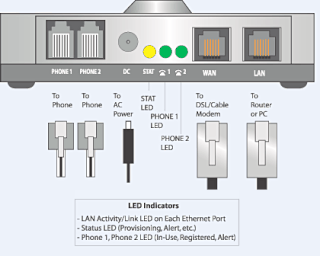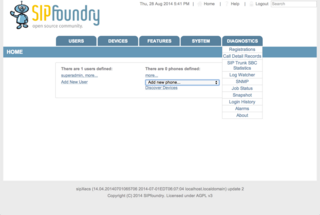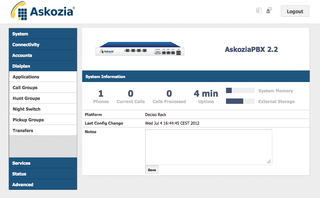Voice over Internet Protocol (VoIP), also called IP telephony, is a method and group of technologies for voice calls for the delivery of voice communication sessions over Internet Protocol (IP) networks, such as the Internet.

An analog telephone adapter (ATA) or FXS gateway is a device for connecting traditional analog telephones, fax machines, and similar customer-premises devices to a digital telephone system or a voice over IP telephone network.

A business telephone system is a telephone system typically used in business environments, encompassing the range of technology from the key telephone system (KTS) to the private branch exchange (PBX).
Direct inward dialing (DID), also called direct dial-in (DDI) in Europe and Oceania, is a telecommunication service offered by telephone companies to subscribers who operate private branch exchange (PBX) systems. The feature provides service for multiple telephone numbers over one or more analog or digital physical circuits to the PBX, and transmits the dialed telephone number to the PBX so that a PBX extension is directly accessible for an outside caller, possibly by-passing an auto-attendant.

Skype for Business Server is real-time communications server software that provides the infrastructure for enterprise instant messaging, presence, VoIP, ad hoc and structured conferences and PSTN connectivity through a third-party gateway or SIP trunk. These features are available within an organization, between organizations and with external users on the public internet or standard phones.

SipXecs is a free software enterprise communications system. It was initially developed by Pingtel Corporation in 2003 as a voice over IP telephony server located in Boston, MA. The server was later extended with additional collaboration capabilities as part of the SIPfoundry project. Since its extension, sipXecs now acts as a software implementation of the Session Initiation Protocol (SIP), making it a full IP-based communications system.
This is a comparison of voice over IP (VoIP) software used to conduct telephone-like voice conversations across Internet Protocol (IP) based networks. For residential markets, voice over IP phone service is often cheaper than traditional public switched telephone network (PSTN) service and can remove geographic restrictions to telephone numbers, e.g., have a PSTN phone number in a New York area code ring in Tokyo.
Mobile VoIP or simply mVoIP is an extension of mobility to a voice over IP network. Two types of communication are generally supported: cordless telephones using DECT or PCS protocols for short range or campus communications where all base stations are linked into the same LAN, and wider area communications using 3G or 4G protocols.
FreeSWITCH is a free and open-source telephony software for real-time communication protocols using audio, video, text and other forms of media. The software has applications in WebRTC, voice over Internet Protocol (VoIP), video transcoding, Multipoint Control Unit (MCU) functionality and supports Session Initiation Protocol (SIP) features.
Text over IP is a means of providing a real-time text (RTT) service that operates over IP-based networks. It complements Voice over IP (VoIP) and Video over IP.
FreePBX is a web-based open-source graphical user interface (GUI) that manages Asterisk, a voice over IP and telephony server.

Snom Technology GmbH is a German company which manufactures Voice over Internet Protocol (VoIP) telephones, based on the IETF standard Session Initiation Protocol (SIP). Snom's products are targeted at the small- to medium-sized business sector, home offices, Internet service providers, carriers, and original equipment manufacturers. The company, founded in 1996 and headquartered in Berlin, is a wholly owned subsidiary of VTech Holdings Limited, since 2016.
An IP PBX is a system that connects telephone extensions to the public switched telephone network (PSTN) and provides internal communication for a business. An IP PBX is a PBX system with IP connectivity and may provide additional audio, video, or instant messaging communication utilizing the TCP/IP protocol stack.

Elastix is a unified communications server software that brings together IP PBX, email, IM, faxing and collaboration functionality. It has a Web interface and includes capabilities such as a call center software with predictive dialing.
A softphone is a software program for making telephone calls over the Internet using a general purpose computer rather than dedicated hardware. The softphone can be installed on a piece of equipment such as a desktop, mobile device, or other computer and allows the user to place and receive calls without requiring an actual telephone set. Often, a softphone is designed to behave like a traditional telephone, sometimes appearing as an image of a handset, with a display panel and buttons with which the user can interact. A softphone is usually used with a headset connected to the sound card of the PC or with a USB phone.
Aculab is a privately held, UK-based limited company that was founded in 1978. It is a designer, developer and manufacturer that specialises in providing API-driven, enabling technology sub-systems for telecommunications related OEM products such as are used in fixed line PSTN, wireless and VoIP networks. Aculab's products are sold worldwide, primarily through direct sales and also via the reseller channel. Aculab's headquarters and R&D facilities are located in Milton Keynes, UK. It has a branch office in Norwood, Massachusetts, USA.

AskoziaPBX is a closed source telephone system firmware. It is a fork of the m0n0wall project and uses the Asterisk private branch exchange (PBX) software to realize all telephony functions.
VaxTele SIP Server SDK is a complete development toolkit, which allows software vendors and Internet telephony service providers (ITSP) to develop SIP Server and (SIP) Session Initiation Protocol based VoIP systems for Microsoft Windows to install computer to computer voice chat, chat rooms, IVR systems, call center services, calling card services, dial/receive computer to PSTN and mobile phone calling services.

The FreePBX Distro is a freeware unified communications software system that consists of a graphical user interface (GUI) for configuring, controlling, and managing Asterisk PBX software. The FreePBX Distro includes packages that offer VoIP, PBX, Fax, IVR, voice-mail and email functions.








